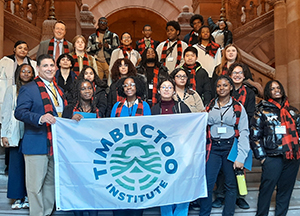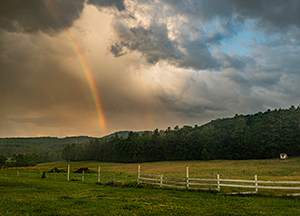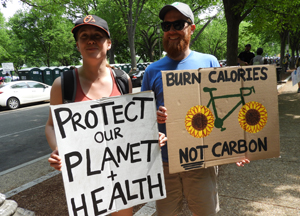
Adirondack Council Issues Pre-Release Peek at 42nd edition of State of the Park
Federal Clean Air Progress & Weakened Wetland Protections
Top Long List of Changes Affecting the Adirondacks in 2023
Illustrated Annual Review of Government Actions Due Out Next Week
ALBANY, NY. – The Adirondack Council’s annual State of the Park Report will be released to the public on Tuesday, October 10, the organization said today.
The overall theme of the report will be Strongest Together -- a reflection of the significant successes of the past year achieved through a growing collaboration between environmental advocates and community stakeholders across the state. Much of that success involved state funding for vital scientific research, Forest Preserve visitor management, and education and career training for a new generation of environmental leaders.
“This sneak preview is about the major accomplishments and setbacks of the past 12 months. As we look to be more comprehensive in our review, we now include a 2023 Top Ten List,” said Adirondack Council Executive Director Raul J. Aguirre. “Some of those were wins at the federal level, including better protection from the power plant smokestacks of the Midwest, which cause acid rain and smog. Some were much more local, such as the outstanding job done by local officials coping with the highly destructive floods that hit during intense rains in July. Their quick and responsible actions saved lives while still preserving sensitive river habitats and aquatic species.”
This year’s State of the Park report is a 28-page illustrated critique of nearly 80 government actions affecting the Adirondack Park over the past year. The report also reveals 15 important actions by individuals and non-government organizations in its “In the Spotlight” section. State of the Park will be available for free on the Adirondack Council’s website (www.adirondackcouncil.org) on October 10.
The State of the Park top 10 list includes the following items that rated a “thumb up” from the Adirondack Council:
Federal Good Neighbor Rule – In March, President Joe Biden’s US Environmental Protection Agency (EPA) issued a final Good Neighbor Rule, an overdue portion of the implementation plan for the Clean Air Act. It bans the accumulation of interstate air pollution that has damaged the Adirondack Park’s forests, soils, and waters with acid rain and smog for decades.
Local Leaders Save Lives, Preserve Rivers – Local government officials in Long Lake (Hamilton County) and in, Newcomb (Essex County), and the Champlain Valley acted quickly to raise alarms and prevent the loss of lives during intense summer flooding caused by heavy downpours in July. Officials implemented lessons learned following tropical storms Irene and Lee in 2011 that largely kept sensitive river sections intact.
Protecting Birds & Bees – the NY Legislature passed a bill banning the use of neonicotinoid pesticides on food crops, which have been linked to die-offs in bird and bee species and a host of human health concerns. It awaits the Governor’s signature.
Wildlife Killing Contests – a bill banning the killing of wildlife for prizes passed both houses of the Legislature. It awaits the Governor’s approval.
All-Terrain Vehicle Minimum Age – Both houses of the Legislature approved a bill increasing the minimum age to operate an ATV alone from 10 to 14. It awaits the Governor’s signature.
Olympic Venues and Forever Wild – the Legislature approved a resolution to amend the NY Constitution to permit recently constructed winter sports venues to remain on the lands that are currently part of the NYS Forest Preserve. It must be passed again by the Legislature that will be elected in 2024 for it to be granted final approval by the voters in 2025. It does not require the Governor’s signature.
American Environmental Justice Movement – the Library of Congress in Washington, DC, is starting a new collection on Environmental Justice (EJ). The first professional papers it requested for the collection were those of Aaron Mair, an EJ pioneer who is currently the Adirondack Council’s Forever Adirondacks Campaign Manager. Mair’s environmental advocacy career spans four decades and counting.
Visitor Management and Overuse – the NY Dept. of Environmental Conservation (DEC) hired a leading national consulting firm to assist it in preparing a plan to address overuse of highly popular Forest Preserve trails and trailheads using methods proven successful in national parks.
The following items received a “thumb down” in the State of the Park report:
Supreme Court and Wetlands -- In May, the United States Supreme Court limited the EPA’s ability to protect wetlands from fragmentation, development, and pollution, narrowing the scope of its jurisdiction without justification. Wetlands help to control flooding and provide vital fish and wildlife habitat. The decision won’t affect Adirondack wetlands, which have state protection down to one acre in size.
Off-Track on Trails – the DEC still needs to find a more effective trail construction regimen following the department’s defeat in the state’s top court over the level of tree cutting that the courts ruled exceeded the material impact threshold. Case in point, the department implemented a draft work plan before the Adirondack Park Agency (APA) had even considered whether it would grant the DEC permission to adopt it.
Forward, then Reverse – the APA made progress on a 50-year-old unfulfilled obligation when it adopted a new mileage cap for roads on the Forest Preserve. It then announced that future APA boards could adopt a contrary interpretation if they wished.
The Adirondack Park consists of both public and private lands, covering one-fifth of New York State. It contains more than three million acres of protected forests. Unlike many other parks, it also contains 130 small, rural communities. Its 11,000 lakes and ponds, thousands of miles of navigable river, and 30,000 miles of brooks and streams are the source waters for most of New York’s rivers.
Established in 1975, the Adirondack Council is a privately funded not-for-profit organization whose mission is to ensure the ecological integrity and wild character of the Adirondack Park. It is the largest environmental organization whose sole focus is the Adirondacks.
The Council carries out its mission through research, education, advocacy and legal action. It envisions a Park with clean water and clean air, core wilderness areas, farms and working forests, and vibrant, diverse, welcoming, safe communities.
For more information:
John Sheehan, Adirondack Council, 518-441-1340




